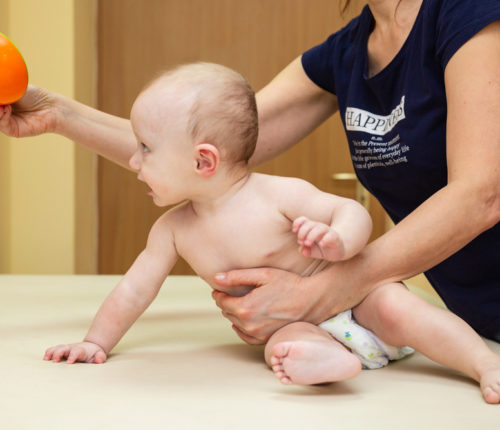
Pediatric Physical Therapy
Pediatric physical therapy is considered a highly effective form of rehabilitative treatment for babies and children who need assistance with balance, muscle control, meeting developmental milestones and much more. Since physical therapy focuses on physical rehabilitation, many physicians recommend it for infants who have developed disorders and disabilities, regardless of whether they suffer from birth injuries or genetic abnormalities.
What is a Physical Therapist?
A physical therapist is a professional who specializes in the treatment of disorders and disabilities that affect an infant’s ability to move optimally and carry out daily life functions. Pediatric physical therapists work with babies and children who have disorders, injuries, and disabilities, some of which include:
- Cerebral palsy
- Spina bifida
- Autism
- Traumatic brain injuries
- Neuromuscular disorders
- Cervical torticollis
Goals of Physical Therapy
Similar to occupational therapists, since each infant’s physical needs will vary according to disability and disorder, physical therapists will create individualized goals for each patient.
For example, babies who are born premature often hold their shoulders up close to their ears, according to physical therapist Kelly Burgio, of the St. Louis Children’s Hospital. A common goal for premature babies is to help maintain proper posture. This is done by gently massaging and pushing the infant’s shoulders down. This also helps promote growth after missing crucial development in utero.
Per Bobbi Pineda of the Washington University’s Occupational Therapy Program, premature infants are not only born underweight, but are also at risk of developing cognitive deficits, motor impairment, and behavior problems as they grow older. Physical therapy can get set specific goals to help babies as they continue to grow and exhibit signs of the aforementioned issues.
“Not only do they have a risk of motor impairment, but subtle learning problems, ADHD, psychiatric disorders and behavioral problems. But the good news is that many are resilient and do well. So, our goal is to find out those key elements that help those babies be more resilient and beat the odds,” Pineda said.
Other types of goals, which may be centered around infants who have genetic abnormalities, genetic disorders, neuromuscular diseases, chronic medical conditions, and more, may include:
- Promoting optimal positions and movement patterns
- Working on appropriate developmental skills
- Managing and reducing pain
- Improving muscle function
- Overcoming limitations
Common Exercises and Tasks
Exercises and tasks taught in physical therapy will depend upon the infant’s age, disorder or disabilities, and how severe the issues are. In general however, the following are common exercises that infants may experience during physical therapy:
- Exercise ball for rolling and crawling development and strength training
- Gentle massaging, muscle kneading, and stretching
- Head control exercises
- Hot and cold compression on affected joints and muscles
- Adaptive equipment training
- Flexibility and balance exercises
Where Does Physical Therapy Take Place?
Pediatric physical therapy can take place in a variety of settings, including doctor’s offices, clinics, rehabilitation centers, hospitals, classrooms, and even in-home sessions. The setting for your baby’s physical therapy sessions depends on the child’s individual needs. Also, it depends on the type of exercises and tasks and if the child needs adaptive equipment. Also, in many instances, is also depends on what your insurance will cover (if applicable).
How to Know if Your Infant Needs Physical Therapy
A physician prescribes and recommends physical therapy if an infant:
- Has excessive or limited joint mobility
- Fails to meet developmental milestones during the first year of life
- Has poor posture
- Favors one side of the body and/or tilting the head to one side only
- Has a diagnosis of cerebral palsy, torticollis, and/or other neuromuscular disorders
- Has floppy and/or stiff muscle tone
- Experiences difficulties with balance and coordination
While it’s important to watch out for the aforementioned signs, it’s also important to speak to your baby’s physician and express any questions and concerns. As previously mentioned, a physician is generally the one to recommend physical therapy, but usually after a complete diagnosis.
Pediatric Physical Therapist Qualifications
Physical therapy is performed by experienced, accredited, and licensed professionals who have successfully finished and passed the National Physical Therapy Examination. Many physical therapists hold a Bachelor Degree of Physical Therapy. Others may hold a Master of Physical Therapy (MTP), a Master of Science in Physical Therapy (MSPT), or a Doctor of Physical Therapy Degree (DPT).
For pediatric physical therapy, your physician will more than likely recommend a therapist who specializes in pediatrics. It’s also a good idea for the physical therapist to be board-certified in pediatric physical therapy through the American Board of Physical Therapy Specialists (ABPTS).
In addition, physical therapy assistants work under the supervision of infant physical therapists. Physical therapy assistants must graduate from an accredited educational program. They must also pass a state-administered national exam to obtain a state license or certification.
Sources:
- http://www.stltoday.com/lifestyles/health-med-fit/health/physical-therapy-helps-premature-infants-thrive/article_c6c6189a-cf5b-5585-b90b-82f3cb9e6526.html
- http://denver.cbslocal.com/2014/01/21/physical-therapy-could-help-preemies-development/
- http://www.ncbi.nlm.nih.gov/pubmed/21719636
- https://www.apta.org/



